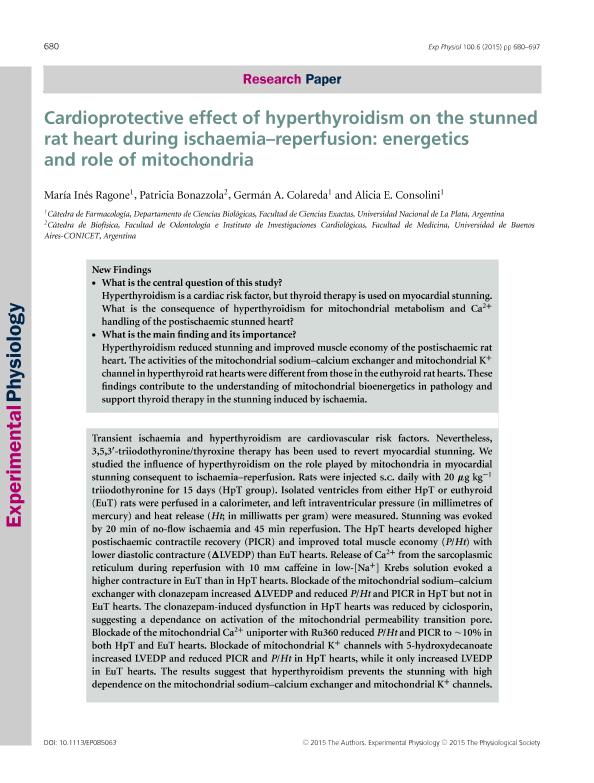Artículo
Cardioprotective effect of hyperthyroidism on the stunned rat heart during ischaemia-reperfusion: Energetics and role of mitochondria
Fecha de publicación:
06/2015
Editorial:
Wiley Blackwell Publishing, Inc
Revista:
Experimental Physiology
ISSN:
0958-0670
Idioma:
Inglés
Tipo de recurso:
Artículo publicado
Clasificación temática:
Resumen
New Findings: What is the central question of this study? Hyperthyroidism is a cardiac risk factor, but thyroid therapy is used on myocardial stunning. What is the consequence of hyperthyroidism for mitochondrial metabolism and Ca2+ handling of the postischaemic stunned heart? What is the main finding and its importance? Hyperthyroidism reduced stunning and improved muscle economy of the postischaemic rat heart. The activities of the mitochondrial sodium-calcium exchanger and mitochondrial K+ channel in hyperthyroid rat hearts were different from those in the euthyroid rat hearts. These findings contribute to the understanding of mitochondrial bioenergetics in pathology and support thyroid therapy in the stunning induced by ischaemia. Transient ischaemia and hyperthyroidism are cardiovascular risk factors. Nevertheless, 3,5,3′-triiodothyronine/thyroxine therapy has been used to revert myocardial stunning. We studied the influence of hyperthyroidism on the role played by mitochondria in myocardial stunning consequent to ischaemia-reperfusion. Rats were injected s.c. daily with 20 μg kg-1 triiodothyronine for 15 days (HpT group). Isolated ventricles from either HpT or euthyroid (EuT) rats were perfused in a calorimeter, and left intraventricular pressure (in millimetres of mercury) and heat release (Ht; in milliwatts per gram) were measured. Stunning was evoked by 20 min of no-flow ischaemia and 45 min reperfusion. The HpT hearts developed higher postischaemic contractile recovery (PICR) and improved total muscle economy (P/Ht) with lower diastolic contracture (ΔLVEDP) than EuT hearts. Release of Ca2+ from the sarcoplasmic reticulum during reperfusion with 10 mm caffeine in low-[Na+] Krebs solution evoked a higher contracture in EuT than in HpT hearts. Blockade of the mitochondrial sodium-calcium exchanger with clonazepam increased ΔLVEDP and reduced P/Ht and PICR in HpT but not in EuT hearts. The clonazepam-induced dysfunction in HpT hearts was reduced by ciclosporin, suggesting a dependance on activation of the mitochondrial permeability transition pore. Blockade of the mitochondrial Ca2+ uniporter with Ru360 reduced P/Ht and PICR to ~10% in both HpT and EuT hearts. Blockade of mitochondrial K+ channels with 5-hydroxydecanoate increased LVEDP and reduced PICR and P/Ht in HpT hearts, while it only increased LVEDP in EuT hearts. The results suggest that hyperthyroidism prevents the stunning with high dependence on the mitochondrial sodium-calcium exchanger and mitochondrial K+ channels. Both HpT and EuT hearts showed a similar and critical role of the uniporter. The HpT hearts have a slow sarcoplasmic reticulum Ca2+ loss and low mitochondrial Ca2+ uptake.
Palabras clave:
Hyperthyroidism
,
Stunned Heart
,
Iscahemia Reperfusion
,
Calorimetry
Archivos asociados
Licencia
Identificadores
Colecciones
Articulos(CCT - LA PLATA)
Articulos de CTRO.CIENTIFICO TECNOL.CONICET - LA PLATA
Articulos de CTRO.CIENTIFICO TECNOL.CONICET - LA PLATA
Citación
Ragone, María Inés; Bonazzola, Patricia; Colareda, German Andres; Consolini, Alicia Elvira; Cardioprotective effect of hyperthyroidism on the stunned rat heart during ischaemia-reperfusion: Energetics and role of mitochondria; Wiley Blackwell Publishing, Inc; Experimental Physiology; 100; 6; 6-2015; 680-697
Compartir
Altmétricas




